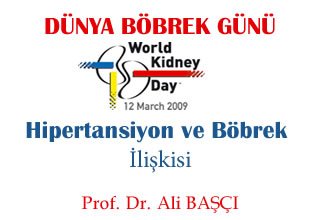
International Society of Nephrology (ISN) and International Federation of Kidney Foundations (IFKF) Taking into account the socioeconomic consequences of the rapid increase in kidney failure in the world for 3 years and the increasing number of people receiving dialysis treatment , declared 12 March as “World Kidney Day” in order to raise awareness of societies on this issue. The main theme of this year’s program was “High blood pressure: keep blood pressure low”. The reason for this is that diabetes is the leading cause of primary disease in dialysis and kidney transplant patients, the number of which is increasing rapidly all over the world and of course in our country, and hypertension is the second. Prevention of chronic renal failure is closely related to the control of hypertension. The kidneys are both the cause and the victim of hypertension.
The role of the kidney in maintaining blood pressure: The relationship between hypertension and kidney disease, or more precisely, a relationship in the sense of kidney disease caused by hypertension has been known since the end of the 19th century. However, the relationship between kidney and blood pressure was drawn attention in 1932 by the researcher Goldblatt, when a kidney vessel in dogs was narrowed with the help of a clip, that is, when less blood went to the kidney, blood pressure increased significantly. In such a case, a hormone called renin is secreted from the kidneys, and this hormone increases blood pressure by stimulating another hormone that constricts vessels and another hormone of the adrenal gland that retains salt. This mechanism normally exists to prevent blood pressure from falling. Because if blood pressure drops, vital organs such as the brain and heart become bloodless. When blood pressure drops under normal physiological conditions, the kidney does two things. First, the hormone called renin is secreted and the vessels contract. Second, salt excretion is reduced. However, if this hormone is secreted excessively in a pathological state, or if excess salt is eaten or the kidney’s salt removal capacity decreases (such as decreased kidney functions), the disease we call hypertension occurs. In other words, the common disease we call “essential hypertension” is a functional kidney disease. Renin mechanism in early ages and salt sensitivity in advanced ages are more dominant in the formation of hypertension.
Kidney victim of hypertension: Since hypertension is a disease that affects vessels, it chooses the kidneys as target organs, such as the heart and brain. We call this hypertensive kidney disease. The reason for this is that the increase in pressure in the glomeruli (balls) consisting of capillaries, which is the smallest functioning organ of the kidney, causes the loss of this organ, the kidneys are covered with connective tissue and shrink and go into failure. For this reason, while the treatment target is 140/90 mmHg in a high blood pressure patient without kidney disease, the lower target value is accepted as 130/85 if there is kidney disease. An important point to be noted is that kidney failure accelerates the process of atherosclerosis, reveals cardiovascular diseases, and a vicious circle and high blood pressure further advances the loss of kidney functions. Hypertension is the trigger in this dangerous, life-threatening process.
Kidney disease as a cause of hypertension: Hypertension is the most common and sometimes the first symptom of kidney diseases, especially in the diseases (nephritis) of the parenchyma, that is, the urinating parts. Hypertension is also a symptom that can be seen in cases where the kidneys are damaged due to stones and inflammation. The vicious circle we mentioned above also works in these cases, and if the blood pressure cannot be controlled, it also accelerates the course of kidney disease. In other words, there is a “chicken-egg relationship” between kidney disease and hypertension.
Hypertension due to renal stenosis: It causes renin secretion from the kidney as explained above, with changes in the vascular muscle that we call fibromuscular dystrophy in young adults, and atherosclerosis plaque narrows one or both of the renal vessels in adults over 40 years of age, and it causes renin secretion from the kidneys, and in a high size that does not fluctuate. causes both systolic and diastolic hypertension. This disease, which we call renovascular hypertension, can also be treated with a method called balloon angioplasty in suitable cases. It occurs as a result of kidney failure in cases where the event is bilateral and methods such as angioplasty are not successful and the stenosis concerns smaller vessels. Due to the aging population, we are seeing these phenomena more often now.
Relationship between Salt and Hypertension: As we mentioned above, salt intake in the diet exceeding the salt excretion capacity of the kidneys, or low salt excretion capacity due to a decrease in kidney mass due to chronic kidney diseases and advanced age are common causes of hypertension. In today’s society, the habit of eating fast-food, the necessity of eating out, the increase in the food prepared with canned salt on our tables has increased and continues to increase the number of people with hypertension. If a patient with hypertension treatment cannot provide salt restriction in meals, he or she cannot benefit from drugs, and has to endure the dangerous life consequences of hypertension.
RECOMMENDED SOURCES:
1. Hypertension: How conscious are we? prof. Dr Ali Başçı www.doktorlarsite.com.tr
2.Chronic Kidney Failure is Increasing Fast ! prof. Dr Ali Başçı www.doktorlarsite.com.tr
3. www.worldkidneyday.org
4. www.turkhipertansiyon.org
Prof Dr ALİ BAŞÇI

